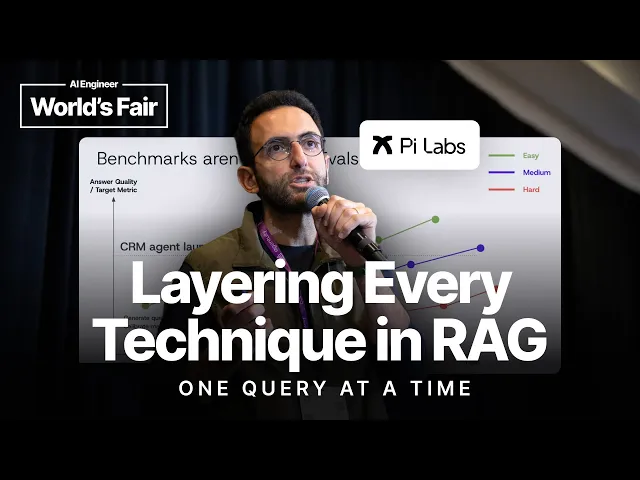Layering every technique in RAG, one query at a time – David Karam, Pi Labs (fmr. Google Search)

Advanced RAG techniques make AI retrievals smarter
In the rapidly evolving landscape of AI retrieval systems, getting machines to understand human queries remains a formidable challenge. A recent talk by David Karam of Pi Labs, who brings expertise from his time at Google Search, dives deep into how Retrieval Augmented Generation (RAG) can be dramatically improved through layered techniques. While most organizations implement basic RAG systems, Karam argues that stacking multiple enhancement strategies delivers exponentially better results for business applications.
RAG has become a cornerstone technology for enterprises looking to ground their AI models in accurate, up-to-date information. But as Karam demonstrates, simple implementations barely scratch the surface of what's possible. By methodically applying a series of techniques that refine how systems interpret queries, retrieve information, and generate responses, organizations can transform mediocre results into remarkably precise answers that truly understand user intent.
Key Points
- Basic RAG implementations frequently fail because they rely on simplistic keyword matching that misses the nuance and context of human queries
- Advanced query transformation techniques like expansion, contextual enrichment, and decomposition can dramatically improve relevance by interpreting user intent more accurately
- Combining multiple RAG techniques in sequence creates compound improvements that far exceed what any single method can achieve
- Retrieval quality metrics like nDCG and faithfulness are essential for measuring improvement, but the ultimate test remains human evaluation
Why Layering Matters: The Compound Effect
The most compelling insight from Karam's presentation is how dramatically different techniques can work together to overcome limitations inherent in basic implementations. While a single enhancement might incrementally improve results, the real magic happens when multiple techniques compound.
This matters tremendously in the business context because enterprises are increasingly deploying RAG systems as customer-facing solutions. The difference between a system that occasionally misses the mark and one that consistently delivers accurate, contextually appropriate responses can determine whether customers embrace or abandon an AI solution. As competition in AI-powered tools intensifies, the quality gap between basic and advanced implementations will likely become a critical competitive differentiator.
Beyond the Presentation: Real-World Applications
What Karam's talk doesn't fully explore is how these techniques translate across different business domains. In healthcare, for example, query understanding takes on additional complexity because medical terminology
Recent Videos
How To Earn MONEY With Images (No Bullsh*t)
Smart earnings from your image collection In today's digital economy, passive income streams have become increasingly accessible to creators with various skill sets. A recent YouTube video cuts through the hype to explore legitimate ways photographers, designers, and even casual smartphone users can monetize their image collections. The strategies outlined don't rely on unrealistic promises or complicated schemes—instead, they focus on established marketplaces with proven revenue potential for image creators. Key Points Stock photography platforms like Shutterstock, Adobe Stock, and Getty Images remain viable income sources when you understand their specific requirements and optimize your submissions accordingly. Specialized marketplaces focusing...
Oct 3, 2025New SHAPE SHIFTING AI Robot Is Freaking People Out
Liquid robots will change everything In the quiet labs of Carnegie Mellon University, scientists have created something that feels plucked from science fiction—a magnetic slime robot that can transform between liquid and solid states, slipping through tight spaces before reassembling on the other side. This technology, showcased in a recent YouTube video, represents a significant leap beyond traditional robotics into a realm where machines mimic not just animal movements, but their fundamental physical properties. While the internet might be buzzing with dystopian concerns about "shape-shifting terminators," the reality offers far more promising applications that could revolutionize medicine, rescue operations, and...
Oct 3, 2025How To Do Homeless AI Tiktok Trend (Tiktok Homeless AI Tutorial)
AI homeless trend raises ethical concerns In an era where social media trends evolve faster than we can comprehend them, TikTok's "homeless AI" trend has sparked both creative engagement and serious ethical questions. The trend, which involves using AI to transform ordinary photos into images depicting homelessness, has rapidly gained traction across the platform, with creators eagerly jumping on board to showcase their digital transformations. While the technical process is relatively straightforward, the implications of digitally "becoming homeless" for entertainment deserve careful consideration. The video tutorial provides a step-by-step guide on creating these AI-generated images, explaining how users can transform...
